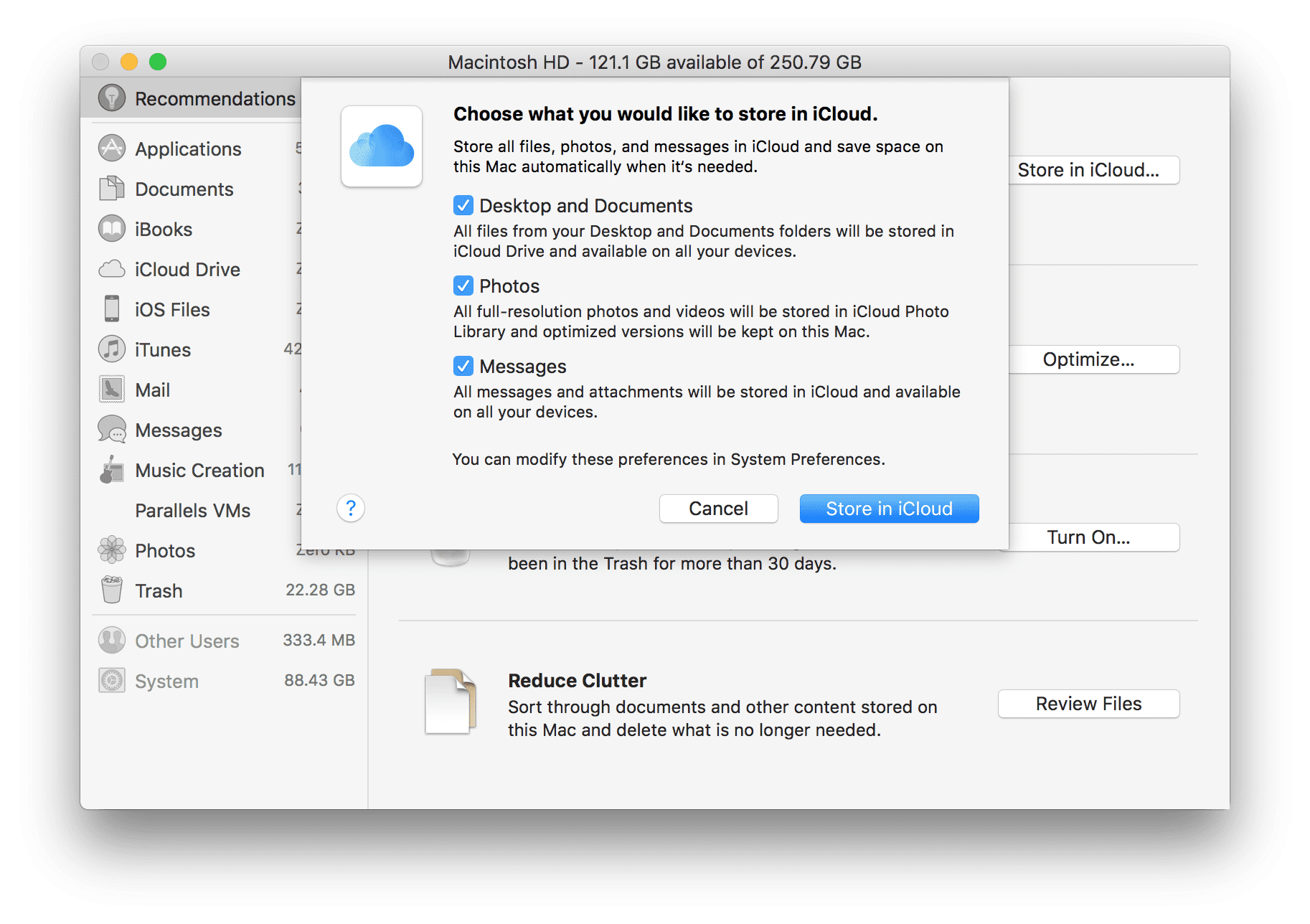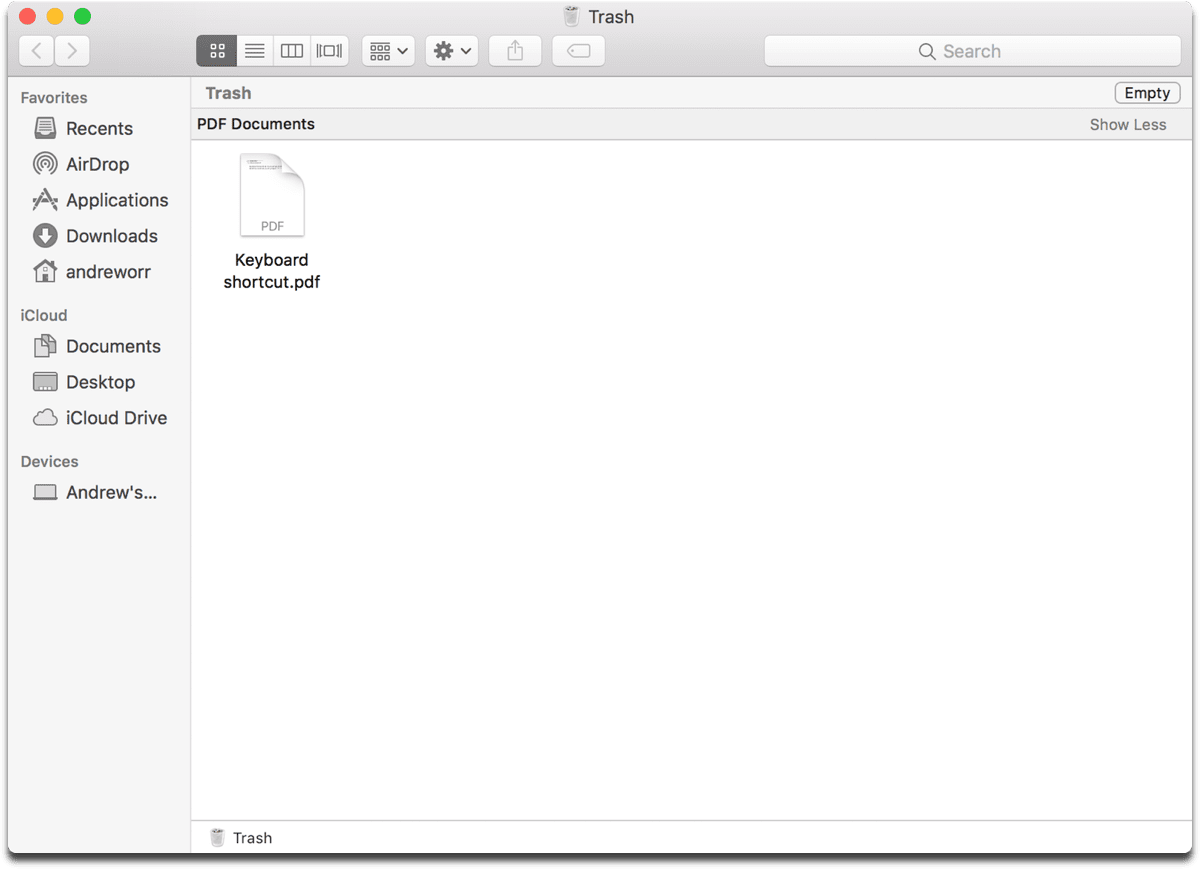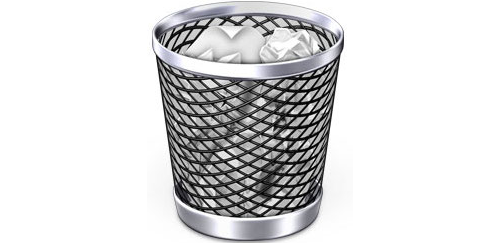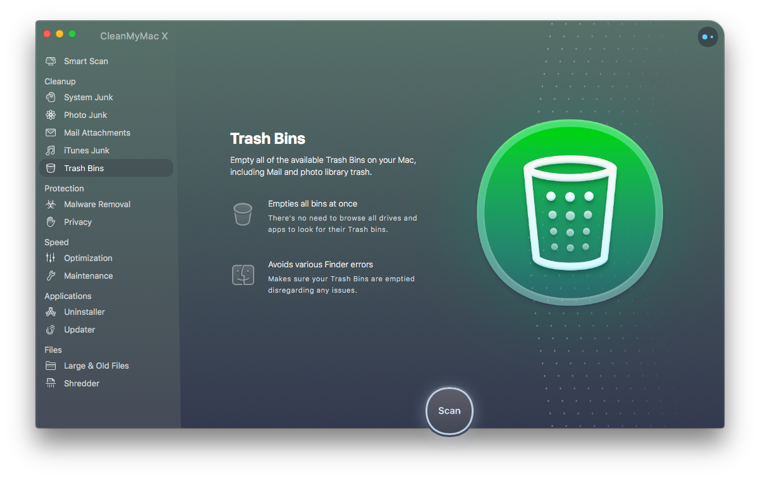Here we cover the reasons why you cannot empty trash on Mac and how to empty trash. In addition to this, we will also discuss a fantastic Mac cleaning utility software that helps optimize Mac. For advanced users who are comfortable using Terminal, we can use a command to force empty trash on Mac. 1 Use Terminal to Empty Trash on Mac. In the days of Mac OS X, the command sudo rm -rf /.Trash/ was used to force empty Trash. But today, for those using El Capitan or Sierra or even something higher, these steps below prove to be more efficient and effective if you intend to force empty Trash using Terminal on Mac.
Can’t empty trash on your Mac? Despite how seemingly easy it is to get rid of deleted files you no longer need anymore, there have been a few complaints by users on some failed attempts to force empty trash on Mac.
Irrelevant files that you may have already dragged and dropped in the needs to be wiped out entirely for two reasons that tend to be of proper importance; one, deleted files still eat up disk space and you need the extra storage space to work with; secondly, when you leave loads of junk files on your computer, you risk slowing down the operating system. And it becomes understandably frustrating when you try erasing junk files from the multiple trash cans and encounter some pressing difficulties. In this post, you will learn the best way to force delete trash on Mac.
1. Use Terminal to Empty Trash on Mac
2. Empty Trash Folder on Mac in “Safe Mode”
1Why You Can't Empty Trash on Your Mac
Erasing files from Trash is supposed to be as easy as locating the Trash icon in the dock and clicking the Empty Trash option, or by simply pressing these three keys successively: Command + Shift + Delete.

However, they are times when things get complicated, and some junk files appear to be inerasable. Here are reasons this is likely to occur:
1. Some files are currently in use, either by an open app, or by a closed app for a background process.

2. The names of some files contain special characters and would be considered as too important to be deleted. Renaming the file makes it possible to be deleted.
3. Some files are corrupted and need repairing.
4. Some files are under system protection integrity.
5. Some files have been locked. Such files display a lock emblem in the lower-left corner of their icons. Right-click on the file and choose 'Get Info.' If the locked option is selected. Deselect the option and empty the Trash.
2Methods to Force Empty Trash on Mac
Whatever the reason is, you can easily learn how to force delete Trash on Mac by following the right way. Here are two solutions below which you can try to force empty the Trash on Mac: use Mac's Terminal or restart your Mac in 'Safe Mode'.
1Use Terminal to Empty Trash on Mac
In the days of Mac OS X, the command sudo rm -rf ~/.Trash/ was used to force empty Trash. But today, for those using El Capitan or Sierra or even something higher, these steps below prove to be more efficient and effective if you intend to force empty Trash using Terminal on Mac:
Step 1: Go to Applications or use spotlight to search and launch Terminal.
Step 2: Insert sudo rm –R and ensure you add a space afterwards (you should not hit the Enter button at this point).
Step 3: Click the Trash icon in the dock, pick all the item you want emptied from Trash. Then Drag the file and folder to the Terminal window you opened before.
Step 4: Now press the Enter button.
Step 5: Insert your administrator password. The password will not be shown being typed into the Terminal.
Step 6: Now press the Enter button again. It's done!
Depending on the number of files and folders you have on Trash, this might take a while.
2Empty Trash Folder on Mac in “Safe Mode”
If your Mac says that the file is in use, you might have a startup item or login item that is using the file. You can consider restarting your Mac in the Safe Mode. Safe mode prevents your Mac from loading certain software as it starts up. Follow the steps below to force empty trash on Mac via Safe mode.
Step 1: Turn on or restart your Mac, then immediately press and hold the Shift key as your Mac starts up.
Step 2: Release the key when you see the login window. ”Safe Boot” should appear in the upper-right corner. And it will boot Mac in Safe Mode.
Step 3: Then empty the Trash and restart your Mac normally.
3How to Get Files Back When You Accidentally Forced Empty Trash?
The good news is that whether you have accidentally emptied your Trash or deleted them intentionally and need them back again, there are third-party means to recover all your lost files to their original state before deletion.
With its user-friendly interface and powerful data recovery modes, AnyRecover is the best bet in getting back your wiped files.
Why Do You Choose AnyRecover to Recover Trash Emptied Files on Mac?You do not need any experience to handle the application; it is easy to use.
It is compatible with leading macOS versions and will help you recover your lost, deleted, or inaccessible contents in different scenes.
It supports all mountable devices including, MacBook/iMac, Memory Card, External Disk, USB Drive, SSD, SD Card,CF/XD/MMC card, etc.
It is able to retrieve your deleted data even if you have emptied the Trash.
After completing the process, AnyRecover will display the results and it supports previewing your photos, Excel, PDF as well as other file types before restoring it.
Steps on How to Recover Trash Emptied Files on Mac Using AnyRecover:
Step 1: Go to Applications, and launch the AnyRecover for Mac. Then select Trash and click Start button to begin the scanning process.
Step 2: The software will automatically scan for trash emptied files. It will take some time because it does an all-round scan.
Step 3: A window would open where you can preview and recover the files you want. Use the Recover button to start the recovery process.
Having trouble emptying the Trash bin on your Mac? Here’s a troubleshooting guide that will help clear trash on Mac.
Generally, deleting trash on Mac is simple. Open the folder and click the Empty button present at the top right corner. That’s all it takes, a single click to get all out from your Mac.
However, there are certain situations when you are unable to empty trash on Mac. This can happen due to different reasons.
And this is when this guide comes to play. Here we cover the reasons why you cannot empty trash on Mac and how to empty trash. In addition to this, we will also discuss a fantastic Mac cleaning utility software that helps optimize Mac.
For advanced users who are comfortable using Terminal, we can use a command to force empty trash on Mac.
Reasons Why You Are Unable To Empty Trash On Mac
- You are running an outdated OS.
- The file you are trying to remove from Trash is in use.
- Installed software or applications are interfering with the functioning of Trash.
- Broken permissions
- Files are locked
How To Empty Trash On Mac
Condition 1: Emptying Trash When The File You Are Trying To Remove Is In Use
A simple restart helps fix various problems. Therefore, when you encounter “The operation can’t be completed because the item is in use,” you need to close the running process. Doing so will help terminate all the running processes that might be interfering with clearing the Trash.
To restart Mac, follow the steps below:
- Click the Apple
- Select Restart from the drop-down list.
This way, you can force quit all running applications and restart your Mac. Once the machine is rebooted, try clearing trash.
This should help fix the problem.
Additional Information
Fixing certain Mac-related problems might be time-consuming. So, if you are looking for a way to save time and still fix all issues, here you go. Using a problem fixer tool called Disk Clean Pro, you can fix most of the problems.
Not only this, Disk Clean Pro thoroughly scans your Mac in no time, and it helps clean all the junk files. The different Trash folders created by different applications that take unwanted storage are also taken care of by Disk Clean Pro.
To use this excellent tool and get rid of all this cluttered data, follow the steps below:
- Download and install Disk Clean Pro
- Click Start System Scan
- Wait for the process to finish. Once done, click Clear Now.
This will help clean most of the Trash items and boost Mac performance in no time.
Condition 2– Deleting Trash on Mac via Advanced File Usage Troubleshooting
Sometimes a startup or login item might be using the file you wish to remove. Therefore, to fix this problem, you need to boot Mac in Safe Mode. This is done so that only the basic apps run, and all the extras are stopped from running automatically at boot time.

To boot Mac in Safe mode and empty Trash, follow the steps below:
- Shut down Mac
- Afterward, turn it and instantly hold the Shiftkey.
- You’ll now be in Safe Mode.
- Here, open the Trash > click Empty, and you’re all done.
Since we are running Mac in safe mode, all the startup apps or login items that might be interfering are now stopped. This helps to empty Trash.
If this doesn’t work, then we have an alternate way to do it. For this, we will use Terminal and will check the app that has locked the file.
To do so, follow the steps below:
- Launch Trash bin.
- Next, press Cmd + Space, and this will open Spotlight.
- Type Terminal and press Return.
- Now, type lsof and press Space.
Note: Isof is used to list down files that are open and in use.
- Head back to Trash > drag the file in Terminal that you want to delete and press Return to run the command.
- You’ll now see a list of the apps using the file.
- Close them.
Note: Terminal does not always give full names of apps. This means, if you are unable to guess the right app, you might have to close several apps.
Condition 3: How To Empty Trash When Files Are Locked
Sometimes when the file you are trying to delete is locked, then you are unable to empty Trash. To rectify it, you need to head to Trash and unlock these files. To do so, follow the steps below:
- Open the Trash.
- Select and right-click the file you want to delete.
- Choose Get Info from the context menu and click the Locked checkbox.
This will help unlock the file, and you will be able to delete selected files from Trash. You can either click the Empty button or right-click > Delete Immediately.
Condition 4: How To Force Empty Trash When Disk Repairing Is Required
A hard disk issue can also prevent you from clearing Tash. To see if this is creating problems, open Disk Utility and use the First Aid function.
To do so, follow the steps below:
- Launch Spotlight by pressing Cmd + Space
- Type Disk Utility and press Return.
- Select the hard disk name that has the file you want to delete
- Click First Aid > Run.
The First Aid function will tell if there are any disk errors. Note, it won’t fix the problems. If you want to repair the disk with errors and delete files from Trash, you need to repair it.
As mentioned earlier, Disk Clean Pro is the app that can do wonders. Using this app, you can solve Mac-related problems and can even fix disk errors. Once that is done, you can force empty trash.

So, give it a try.
Condition 5: How To Force Clean Trash Folder
Even after following all the fixes, we explained. If you are unable to empty trash, there’s a way to do it that is via the Dock.
Press Option key and empty the Trash without even launching it.
If a file is locked, you can unlock it and then delete it while holding the Option key. Alternatively, you can try holding Option when you click the Empty button.
Can't Empty Trash Mac
Holding the Options key bypasses locks on the file. This is an effective way to unlock files and resolve mac trash won’t be an empty problem.
Another option is to use a Terminal command. This will force empty trash and will override locks. This command also helps override other restrictions.

- Open Spotlight and enter Terminal and press Return.
- You will now see the Terminal windows. Here, type sudo rm -R and press Space. This command will force-delete files.
- Now, head back to the Trash > drag the files you want to delete to the Terminal window.
- Press Return.
- Enter Mac’s administrator password when asked for.
- Press Return to confirm and run the command.
Deleting Files Without Moving them to Trash
Do you have a habit of putting files into Trash? Hold on, this isn’t the only way to delete files. If you want to move pass emptying Trash, use Command + Option + Delete when deleting files. This way, you won’t ever have to clear Trash on Mac.
Caution: Once you use Command + Option + Delete , you cannot get the file back. So, use it when you are sure about completely deleting the file.
This is it. Now you have all the required knowledge to force empty Trash. If you liked the post and found it helpful, share it with others. However, if you think something is missing, let us know.
We’d love to hear from you. Stay connected for more such informational articles.
Frequently Asked Questions
Q1. Does Emptying Trash Permanently Delete Mac?
Yes. Once you clear the trash, the only way to get those files back is to use a recovery tool. But remember, there’s no 100% guarantee that you will be able to recover all files.
Where Is Trash On Mac
Q2. Why Can’t I Empty My Trash On My Mac?
You cannot empty Trash on Mac due to the following reasons:
- The app might be running in the background or use.
- Files are locked.
- Insufficient privileges
- Files moved to Trash were saved on an external drive.
Q3. How To Resolve Unable To Empty Trash On Mac Due To Permissions?
To resolve the problem, you can try following the steps below:
- Restart your Mac
- Log out and log back in.
- Force-quit the Finder by pressing
Option + Command + Escape. Alternatively, you can choose Force Quit from the Apple menu or hold theOption key >right-click the OS X Dock Relaunch.
Force Empty Trash Macos Catalina
Q4. How Long Does It Take Empty The Trash On A Mac?
It doesn’t take long to empty trash; however, if you have like over 10,000 items or so, it might take 15-20 minutes.
Q5. Will Emptying Trash Speed Up Mac?
Emptying Trash will free up space, thereby resulting in speeding Mac performance. If you want, you can enable the option to delete items from Trash automatically. To do so, follow the steps below:
Note: Auto-empty Trash feature requires macOS Sierra 10.12 or newer
- Click the Apple logo > About this Mac > Storage > Manage > enable Empty Trash Automatically (this will delete items from the Trash after 30 days)
Q6. How Often Should I Empty The Trash On My Mac?
Those who often delete files should empty trash regularly. However, if you have enabled automatically emptying Trash, it is best. This way, after 30 days, Trash will be cleaned automatically.
Neat and Optimized Mac
Emptying Trash is an excellent way to clean up your Mac and make it run smoothly. This can be done by using the manual steps explained above or can use Disk Clean Pro for that matter.
This best Mac cleaner will do the trick in no time. So, give it a try to give your Mac a boost.